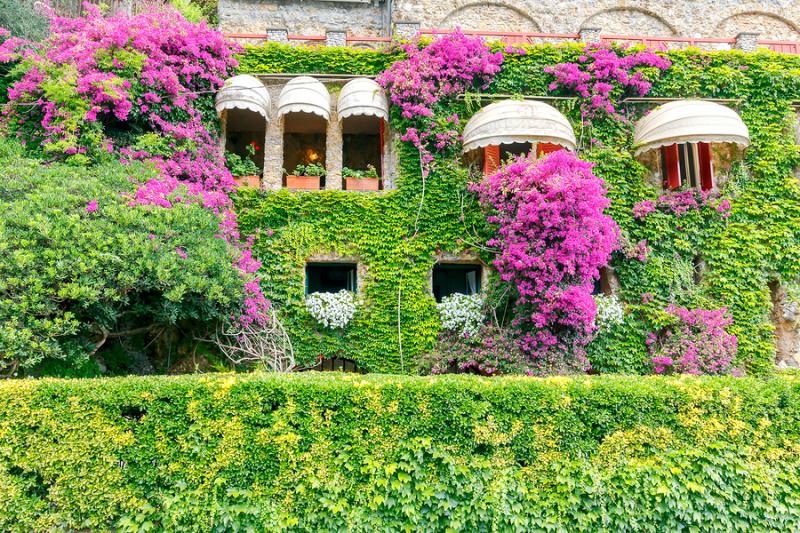When you visit some parts of the world, you'll catch them in full bloom. The flora and the fauna are out for everyone to see. But when it comes to flowers, and that full bloom experience, Liguria is one of the finest of its kind.
San Remo, in particular, is fabled for its lush, beautiful scenery. Everywhere you look, there are flowers, palm trees, tropical vegetables... for example, take a stroll through the streets of San Remo, and you'll encounter a rainbow of flower colour. Look over there – there's a hibiscus bush. Over to the other side, the lilac or yellow coloured violets are competing for your attention. It's not just the streets, however. There are special parks and gardens that are bursting at the seams with all kinds of flower species from around the world. So many other flowers, including roses, begonias and carnations, are cultivated in the San Remo region.

Climate Range
So what makes San Remo the perfect spot for its blooming reputation? Part of the clue is in its climate. Because of its unique position in the Mediterranean, San Remo's climate is affected by a number of key aspects, such as the local winds, the outline of the coast, and also the Alps. The mountains function as a kind of shield that protects the flowers from potential harm. Just as crucially, in the Winter season, while the temperature in the region tends to be low, the weather tends to be mild. Low rain levels and high sun levels mean that floriculture is still possible in those shaky Winter months.
Boosting The Economy
In addition to providing beautiful, natural sights for all to see, the flowers of the region are also important to the economy. It's said that more than three quarters of the turnover from the local agriculture sector comes from flower production.
As far back as the 19th century, floriculture was a popular notion, with production of field-grown cut flowers like wallflowers and daffodils. The following century would see floriculture trade flourish in earnest – with rail facilities making it possible to transport the flowers to other countries. Also, industrial production of cut flowers was also taking off, as the suitable climate of the region made it possible for outside cultivation to take place.
Market Must
One of the most important flower markets in the whole of Europe is the San Remo Flower Market. It is located approximately six kilometres east of the region, and stands as one of the quintessential flower markets of its type.
This flower market spans a huge area, with the floriculture space spanning 3300 hectares. The market provides a comprehensive selection of cut flowers in addition to foliage and leaves. In addition to the area for market facilities, there are also ample facilities for parking, loading and unloading, and a refrigerated flower warehouse.
Pick of the Parade
A great showcase for the flowers of San Remo is that of the annual Flower Parade – or Corso Fiorito.
This show-stopping event takes place in March (the next one is due on 12th March 2017), and is a great opportunity to welcome in the new Spring season. Originally, the event was conceived more along the lines of a straightforward but still impressive showcase of flowers.
But today, the carnival ensures that anyone coming to this event will remember it forever. The event includes a traditional parade of floats – all of course, decked out with flowers! These floral floats boast a wide range of flowers arranged in displays and sometimes mosaics. Music is provided by marching bands, who add that little extra atmosphere.
 San Remo's Corso Fiorito, photo credit: Italyholiday.it
San Remo's Corso Fiorito, photo credit: Italyholiday.it
Do Battle
Other Liguria regions are also well known for their flower showcases. One notable traditional event is that of the Battle of Flowers which occurs in Ventimiglia.
It's an event that was originally used by farmers to mark the rebirth of vegetation in the Spring season and thank Mother Earth for providing them with healthy crops throughout the year. As time progressed, the event again took on a carnival style procession. It's a great way to witness the local flora, as the papier mache floats are vividly decorated in colourful flowers – complete with additional entertainment from bands and dancers. This is another crowd-pleasing event that offers great spectacle and also the chance for spectators and participants to dress up in colourful outfits.

Most to Coast
Between the French Border and Genoa, this stretch of Liguria is well known for its flowers. It's known either as La Riviera di Ponente or La Riviera dei Fiori (Flowering Coastline).
The vistas here are the sort of sumptuous pictures that you'd find on the most eye-catching postcards. From the palm trees at the seaside promenades to the olive groves gracing the hills, La Riviera di Ponente lives up to its flowering reputation
La Riviera di Ponente is renowned for its prodigious production of flowers, and it's said that every year, around 20,000 tons of flowers (such as carnations, roses and mimosas) are exported, again creating a great boost to the local economy.
Villa Time
If you're looking to go to at least one botanical garden in Liguria, then a good destination if that of Villa Hanbury (also known as Giardini Botanici Hanbury), which is currently operated by the University of Genoa.

The Hanbury in question was Sir Thomas Hanbury, who bought the Palazzo Orengo property in the 1860s. Over a period of time, Hanbury set to work to create a garden paradise to remember. He would do so over the next few decades with the assistance of people such as his brother Daniel, botanist and landscape designer Ludwig Winter, and scientist Gustav Cronemayer.
Hanbury passed away not long after the turn of the 20th century, but the work continued under the guidance of his daughter-in-law, Lady Dorothy Hanbury. By 1912, if you'd taken a look at the catalogue of the garden (Hortus Mortolensis), you would have discovered that it was now home to 58,000 species.
Alas, the gardens were affected by the Second World War, and were ultimately sold to the State of Italy in 1960. By 1983, the task of caring for and restoring the gardens was taken on by the University of Genoa, with work starting four years later. By the year 2000, the restored gardens had been declared a nature preserve, and today, remain as one of the finest botanical sights in the world.














